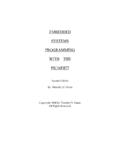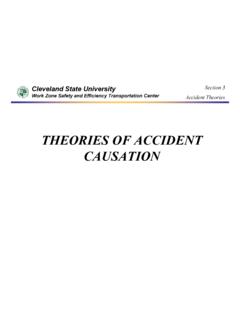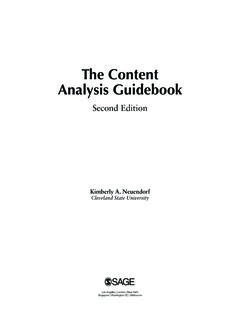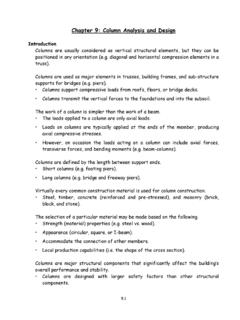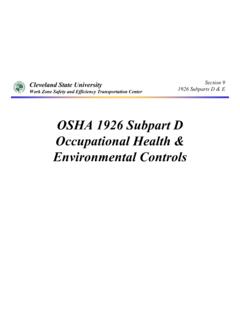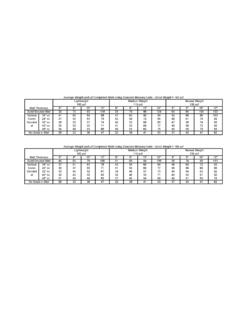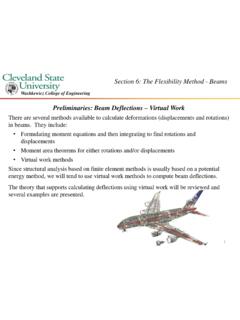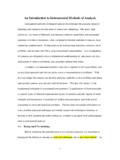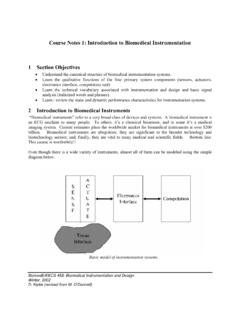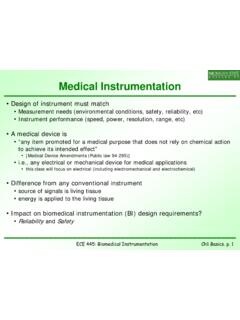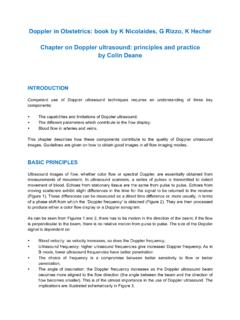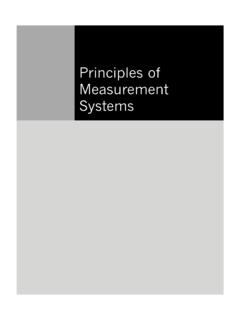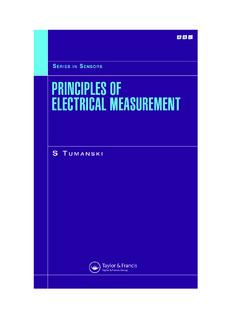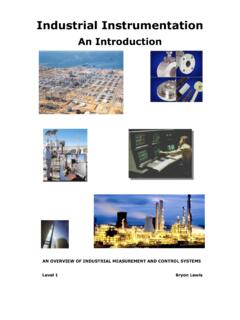Transcription of Types of Applications of Measurement Instrumentation
1 Types of Applications of Measurement Instrumentation WHY STUDY Measurement SYSTEMS? he study of any subject matter in engineering should be motivated by an ap preciation of the uses to which the material might be put in the everydayTpractice of the profession. Measurement systems are used for many detailed purposes in a wide variety of application areas. Our approach will be to start with some specific Applications in a specific industry and then generalize this picture by developing classijication schemes that apply to all possible situations. While Measurement is used in many contexts, I want to introduce some basic ideas using the automotive industry as an example. This industry employs measure ment in many ways and is thus a good choice for exploring the various uses of Measurement tools.
2 In the text title, the term Measurement system is meant to in clude all components in a chain of hardware and software that leads from the mea sured variable to processed data. Let us start examining the use of Measurement in the automotive industry at the beginning, that is, with the conceptual design process, where a new automobile or truck is first conceived and the basic configu ration developed. Because a modem automobile uses as many as 40 or 50 sensors (measuring devices) in implementing various functions necessary to the operation of the car, an automobile designer must be aware of the instruments available for the various measurements and how they operate and interface with other parts of the system.
3 As new sensors are invented, designers must keep up with such develop ments since they may allow improvements in car design and operation. Lack of such sensoF-hwiedge eaa sevedy festrict the range of designs that one can conceive, thus limiting improvements in overall car performance. While sensor speciahts will at later stages of design consider the measuring devices in great detail, the conceptual designer must have a basic appreciation of their capabilities, so that the initial design does not neglect any useful possibilities. 3 4 PART I General Concepts Once the conceptual stage of design is well underway, Measurement system considerations arise in new contexts. Many engineered products are nowadays de signed using the methods of concurrent engineering where design and manufactur ing are integrated, rather than being considered sequentially, as was often the case in earlier times.
4 Before concurrent engineering became common, design was gen erally completedfirst, manufacturing considerations addressed only late6 and costly revisions and delays (or poor designs) were often the result. With concurrent engi neering, product design concepts are not frozen until both function and manufac turability have been reconciled. That is, the design and manufacturing engineers work in coordinated teams, blending their expertise right from the beginning of the design process. Both functionality and manufacturability considerations often require the design process to include laboratory testing of one kind or another. For example, if a new material is being considered, we may need to run strength tests to develop data needed by the design engineers.
5 Or, a new or revised manufacturing process may require statistical response surface experiments to find the effects of process variables on performance andor cost. Finally, availability from suppliers of new components, such as improved shock absorbers, may require performance testing to decide whether their use is warranted in the new design. We see that laboratory testing and the associated Measurement systems are thus a vital part of the design process. As design and development proceed, prototype subsystems and finally entire vehicles will be produced. These are used as test beds to evaluate performance and then feed back information to the desigdmanufacturing teams. That is, initial designs usually have unsuspected flaws, which are revealed by building and testing the prototypes.
6 Also, pencil and paper or computer-aided designs always are based on theories that are never exactly correct, so experimental testing is needed to verify, or improve, theoretical calculations. We begin to appreciate that design relies heavily on experimental testing at every stage of the process. We have seen that experimentation is often needed during the design phase to help in the development of the manufacturing processes for the product. Once the design has been finalized, then manufacture of the product in quantity, rather than the one of a kind mode used during development, can commence. When we ex amine actual production machinery and processes, we often find that these manu facturing tools are controlled by a so-calledfeedback mechanism.
7 In such a scheme, some quality parameter of the part produced is measured with appropriate sensors. This measured value is compared with a desired value of the parameter, and if the desired and measured values do not agree within some allowable tolerance, a controller adjusts the machine or process until the product is on specification. Perhaps the most obvious example of this general situation is the machining of parts to specific dimen!oiocHere the measuring devices areprecision gages that mea sure shaft diameters, hole sizes, lengths, etc. Robots used to weld, spray paint, or assemble parts are also usually feedback devices that use motion and force sensors E. , Engineering Experimentation, McGraw-Hill, New York, 1995,p.
8 273. CHAPTER I Types of Applications of Measurement Instrumentation 5 to control the robots operation. Again it is clear that Measurement plays a signifi cant role in almost every manufacturing enterprise. Turning now to the final product, a modem automobile, as mentioned earlier, relies on a multitude of sensors for its optimum operation. Some of these play es sentially a monitoring role, that is, they measure and display to the driver, infor mation useful for safe and efficient operation of the car. Speedometers tell us the vehicle s speed, while tachometers display engine RPM. Fuel gages keep track of the gas supply, and temperature sensors warn of overheating. Recent developments include use of the Global Positioning System (based on satellites) to locate the car on an electronic map and guide the driver to a desired destination.
9 Many other sen sors are part of feedback controls that optimize engine operation by measuring such variables as atmospheric pressure, air flow rate, fuellair ratio, engine temperatures, etc. Acceleration sensors (accelerometers)measure vehicle motion during a crash and signal air bags to deploy if the crash is sufficiently severe. Brake-cylinder pres sure and wheel-speed sensors control the antilock braking system to give better driver control on slippery surfaces. To keep costs down, many automotive sensors use micro-electro-mechanical systems (MEMS). Using manufacturing techniques borrowed from integrated-circuit technology, miniature sensors are mass produced at low cost from materials such as silicon.
10 A recent example is the GyroChip, a replacement for the classical gyroscopic instrument used to measure angular velocity. This sensor is being used in cars to augment vehicle stability during severe or emergency maneuvers. CLASSIFICATION OF Types OF Measurement Applications I used the automotive industry as a familiar example to introduce you to the varied Applications of Measurement in engineering. To help you organize your thinking on this subject I now want to generalize the topic of Measurement Applications . Fortu nately, all the specific examples I gave from the auto industry, and in fact, examples from any industry, can be classified into only three major categories: 1. Monitoring of processes and operations.
